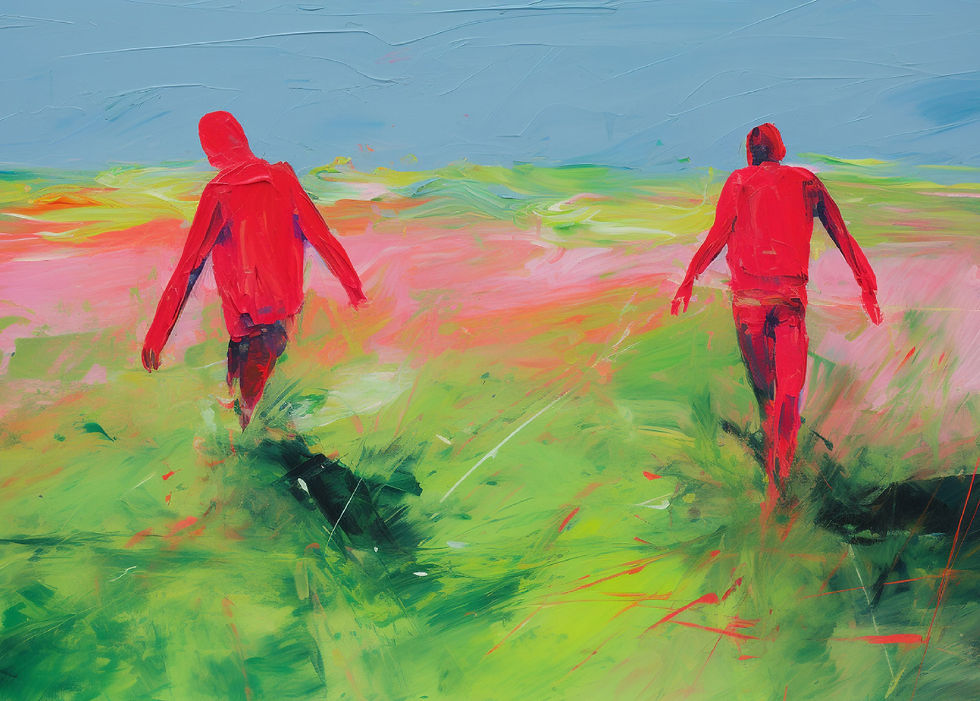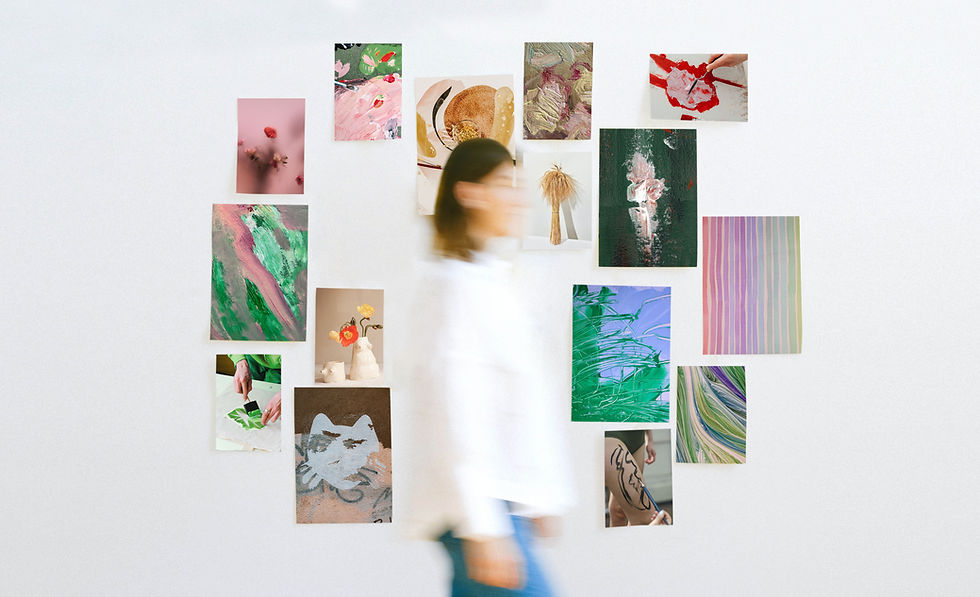Seeing Others as More Than Reflections of Ourselves
- Kit Louis

- Sep 28
- 4 min read
Updated: Oct 13
How intersubjectivity shapes the way we connect — and how art helps us see beyond the mirror.

Have you ever felt frustrated when someone expects you to feel or think exactly as they do — as though your inner world should align perfectly with theirs? It can feel suffocating, as if difference is somehow disloyal.
As an art therapist, I often notice how this dynamic surfaces not only in families but also in the therapy room. Beneath our interactions lives a quiet question: Can we truly see the other as separate from ourselves — and still stay connected?
That delicate balance sits at the heart of intersubjectivity — the awareness that two minds can meet, influence each other, and remain distinct.

Understanding Intersubjectivity Through the Therapeutic Lens
From infancy, our first experiences of connection happen through gaze, tone, and movement — what developmental researchers call primary intersubjectivity: the smile that meets a smile, the coo answered by another’s warmth. These early exchanges lay the groundwork for emotional safety and the first glimmer of “you” and “me.”
Later, secondary intersubjectivity emerges: a baby points to a toy and looks back to see if the caregiver notices too. That shared attention toward a third thing — an object, a sound, an artwork — becomes the seed of empathy and collaboration.
In art therapy, this process unfolds again and again. A child looks at their painting, then to me — checking if I see what they see. We share a gaze not just at the image, but through it. Each artwork becomes a small rehearsal of how to exist with another mind, without losing one’s own.

When We Struggle to See Others Clearly
Some people reach adulthood without a consistent experience of being “seen” as separate. When early relationships lack emotional attunement, a person may learn that sameness equals safety.
In therapy, this can appear as needing constant agreement, mirroring, or compliance — or, conversely, as withdrawal when difference feels threatening.
I sometimes meet clients who hold tightly to their own interpretations, not because they lack empathy, but because difference feels like rejection. For others, it’s easier to adapt completely to others’ moods and expectations, fearing that their own view might cause rupture. Both responses protect against the discomfort of otherness.
Research reminds us why this is so central. Moll, Johannsen, and Reddy (2021) describe how early triadic interactions — shared attention between infant, caregiver, and object — build the neural and emotional architecture for perspective-taking. Harrison and Tronick (2022) add that meaning-making is never solitary; it is co-created, embodied in gesture and rhythm. As therapists, we witness this daily in the pauses, sighs, and brushstrokes between words — the subtle choreography of two nervous systems seeking safety in connection.
Art as a Bridge Between Inner Worlds

Art provides a language that bypasses defensiveness. When a client paints anger as a storm or builds a wall out of clay, they externalise what once lived entirely inside. This shared third — the artwork — becomes a bridge between worlds.
Here, intersubjectivity is not only cognitive but somatic. I might breathe a little slower as a client presses clay with quiet intensity. Our rhythms begin to sync. Through creative attunement, the nervous system learns that being with another doesn’t require merging or self-erasure.
In families, schools, or workplaces, the same principle applies: shared creativity invites dialogue rather than demand. Whether through joint collage, role-play, or co-creating a mosaic, we practise curiosity — learning that difference need not divide.
A Gentle Closing: Holding Space for Otherness
Intersubjectivity isn’t a milestone we reach; it’s an ongoing practice — a way of seeing that keeps space between self and other alive.
When I sit beside a client’s artwork, I remind myself: this image belongs to them, not me. My task is to stay curious, not to interpret too quickly.
When parents, teachers, or partners do the same — listen without correction, allow disagreement without withdrawal — relationships deepen.
Seeing another clearly doesn’t mean agreement. It means giving them enough room to exist.
Even small shifts — slowing down before responding, noticing when sameness feels safer than difference — can begin to transform the way we relate.
Perhaps art teaches us this best: that two hands can work side by side on one canvas, each leaving their own mark, and still create something whole.
"To see another clearly is to make space for them to exist."

References
Carpenter, M., Salter, G., & others. (2025). The developmental origins of joint attention: Infants’ early joint attention in free play and structured tasks between 6 and 10 months. Developmental Science. Advance online publication. https://www.ncbi.nlm.nih.gov/pmc/articles/PMC11947298/
Harrison, A., & Tronick, E. (2022). Intersubjectivity: Conceptual considerations in meaning-making with a clinical illustration. Frontiers in Psychology, 13, Article 715873. https://www.frontiersin.org/articles/10.3389/fpsyg.2021.715873/full
Moll, H., Johannsen, J., & Reddy, V. (2021). From primary intersubjectivity to shared intentionality: The development of triadic interactions in infancy. Frontiers in Psychology, 12, Article 667679. https://www.frontiersin.org/articles/10.3389/fpsyg.2021.667679/full
Reddy, V. (2008). How Infants Know Minds. Harvard University Press.
Trevarthen, C., & Aitken, K. J. (2001). Infant intersubjectivity: Research, theory, and clinical applications. Journal of Child Psychology and Psychiatry, 42(1), 3–48. https://doi.org/10.1111/1469-7610.00701




Comments